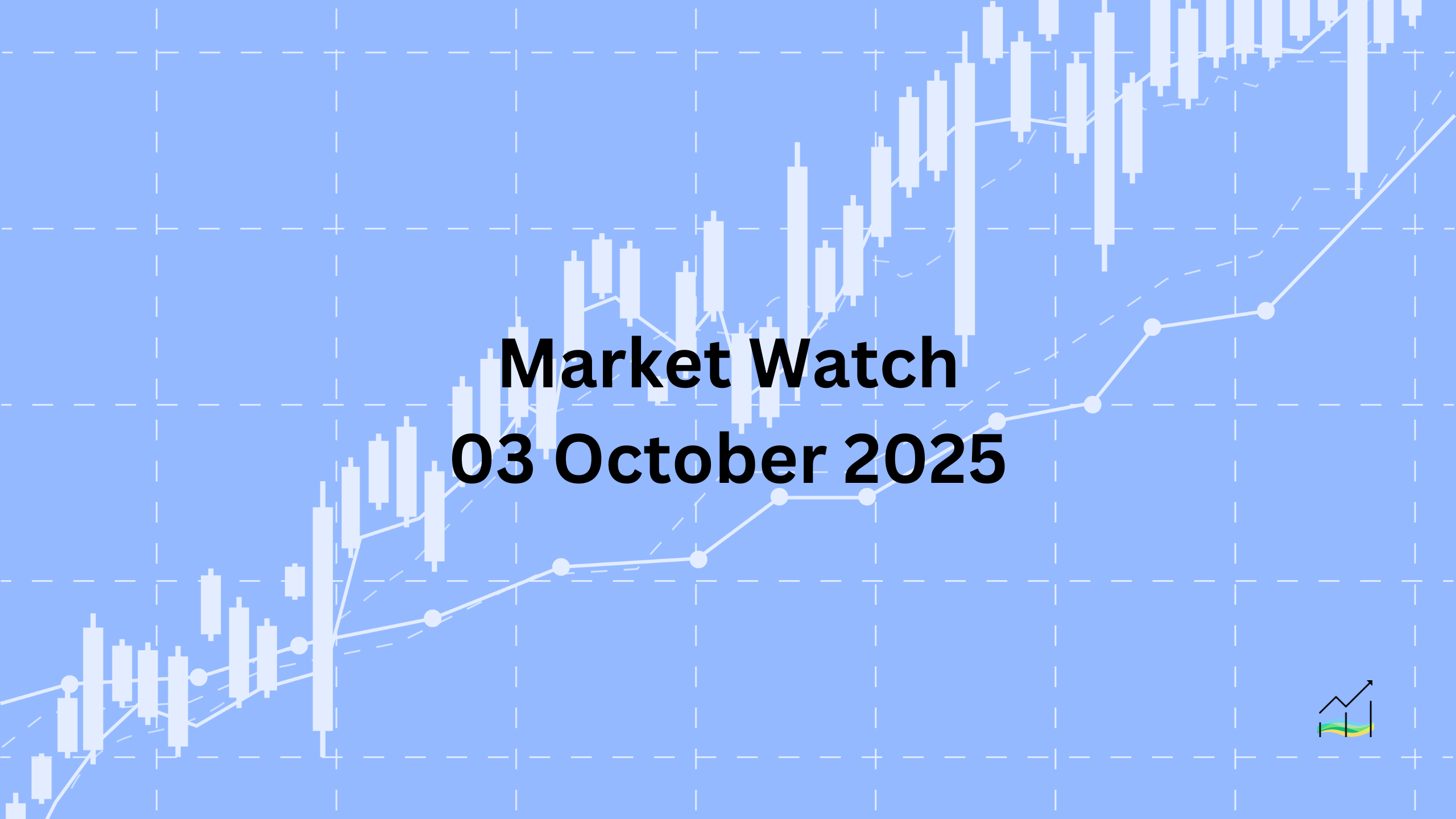03/10/2025 Market Watch

Risk Rally Builds, Dollar Falters
Key Takeaways:
- The US dollar is soft, trading mostly inside yesterday’s ranges.
- Yen weakens on higher Japanese unemployment.
- Global equities rally, led by Asia and Europe.
- Gold holds firm near record levels, oil stabilises after a sharp drop.
The US dollar is trading softer but remains within yesterday’s ranges. The Japanese yen is the only G10 currency losing ground against the greenback after an unexpected rise in the unemployment rate. Sterling is also under pressure following the final September composite PMI, which slipped to just above the 50 boom/bust threshold. Most other major currencies are modestly stronger, while emerging market currencies continue to firm. The JP Morgan and MSCI EM currency indices are up 0.2% to 0.3% this week, reflecting broad risk appetite.
Equities are pushing higher across regions. In Asia, Japan’s major indices climbed over 1%, while Taiwan’s market gained 1.45% despite pressure from the US to relocate chip capacity. Hong Kong was the only major market to fall. In Europe, the Stoxx 600 has risen for six consecutive sessions, with a 2.8% weekly rally marking its strongest performance in five months. US index futures are also trading higher. Bond yields are narrowly mixed, with the 10-year US Treasury at 4.09%, sitting in the middle of its recent range. Gold remains firm after touching a record near $3897 yesterday, posting its seventh straight weekly gain. Oil has stabilised after November WTI dropped more than 2% to approach a four-month low near $60.
United States of America
Overview
The Dollar Index reversed a four-day decline, recovering nearly half of its post-Fed losses to reach a three-day high near 98.15. Monday’s high was closer to 98.20, but there has been no follow-through today. The index has remained below 98.00 and touched a session low near 97.70 during European trading. The September employment report is expected to be the key focus, but the ongoing government shutdown continues to delay several economic data releases.
Despite these disruptions, it is inaccurate to say the Fed and investors are flying blind. The reliance on private sector data has grown, covering indicators such as corrugated cardboard orders, train car loadings, holiday wrapping paper sales, PMI/ISM surveys, ADP employment data, Boeing orders, auto sales, Challenger job cuts, house prices, and sentiment surveys from the University of Michigan and the Conference Board. In addition, various regional Federal Reserve surveys provide further insight, none of which are affected by the shutdown.
Markets will also watch the final services and composite PMI figures, as well as the ISM services index. Preliminary data indicated slower growth in services and composite output, with readings at 53.9 and 53.6, both at three-month lows. The ISM services index is expected to ease to 51.7 from 52.0, while the employment sub-index has remained at 50 since June.
Economic Drivers
- Dollar Index recovered after four days of declines, reaching a three-day high.
- Government shutdown is delaying several official data releases.
- Policymakers and investors are increasingly relying on private sector indicators for economic insights.
- Preliminary PMI data signals slowing service sector momentum.
- ISM services is expected to soften, with employment indicators remaining flat since mid-year.
Data and Events
- 03 October 2025: Average Hourly Earnings
- 03 October 2025: Non-Farm Employment Change
- 03 October 2025: Unemployment Rate
- 03 October 2025: ISM Services PMI
Price Action
- Dollar Index briefly rallied to near 98.15, then pulled back below 98.00.
- Session low recorded near 97.70 in Europe.
- No follow-through buying after yesterday’s rebound.
Key Points:
- Dollar Index recovered but remains capped below 98.00.
- Government shutdown is delaying data but alternative indicators fill the gap.
- PMI data points to slower service sector activity.
- ISM services expected to ease, with employment flat.
Europe
Overview
The euro fell below $1.17 for the first time in three sessions, reaching a weekly low just under $1.1685. The upside had stalled near $1.1780 earlier in the week, which marked the 50% retracement of its post-Fed pullback. Close to 3 bln euros in options expired slightly above this level, adding weight to price dynamics. Today, the euro is trading between $1.1715 and $1.1745.
On the data front, the flash PMIs provided a reliable signal, making the final report uneventful. The composite PMI rose to 51.2 from 51.0, marking a fourth straight monthly gain and the highest reading since May 2024. The Q3 average came in at 51.0, the strongest since Q2 2024. French industrial output fell 0.7% in August, against expectations for a 0.3% increase, though this was partially offset by a sharp upward revision in July figures. Meanwhile, eurozone producer prices declined 0.6% year-over-year in August after a 0.2% rise in July, the first negative print this year.
In addition, reports indicate that the EU is considering raising steel tariffs to 50% to align with US levels. The current temporary mechanism applies a 25% levy above quotas and is set to expire next year, signaling a potential shift in trade policy.
Economic Drivers
- Composite PMI rose to 51.2, its highest since May 2024, marking four consecutive months of expansion.
- French industrial output unexpectedly fell 0.7% in August, offset partly by an upward revision for July.
- Eurozone producer prices declined 0.6% year-over-year in August, the first negative reading of the year.
- EU is considering raising steel tariffs to 50%, matching US levels, as current temporary measures are due to expire next year.
Data and Events
- 03 October 2025: Final Services PMI
- 03 October 2025: PPI
- 03 October 2025: ECB President Lagarde Speaks
Price Action
- Euro broke below $1.17, recording a low near $1.1685.
- Upside stalled near $1.1780 earlier in the week.
- Options expiries near $1.17 influenced trading.
- Current range is $1.1715 to $1.1745.
Key Points:
- Euro slipped below $1.17 amid option expiries and fading momentum.
- PMI data confirmed continued expansion, hitting the strongest levels since mid-2024.
- French industrial output and producer prices surprised to the downside.
- EU may raise steel tariffs to 50%, aligning with US policy.
- Market focus remains on growth trends and trade developments.
Japan
Overview
The dollar found support against the yen near JPY146.60 on Wednesday and Thursday, holding slightly above the trendline drawn from the April and July lows. Although this level was briefly breached after the Fed’s rate cut on 17 September, the pair quickly recovered, closing back above the line. In North American trading yesterday, the dollar strengthened to JPY147.50 and has now moved slightly above JPY147.80, near the 20-day moving average. The 38.2% retracement of the recent decline from last Friday’s high of around JPY149.95 lies near JPY147.90, making it a key technical area to watch.
On the economic side, Japan reported an unexpected increase in the unemployment rate for August, rising to 2.6% from 2.3%, the highest since March 2023. The job-to-applicant ratio also fell to 1.20 from 1.22, marking its lowest level since 2022. Final PMI figures were largely unchanged from preliminary estimates, with the composite PMI easing slightly to 51.3 from an initial 51.1, compared to 52.0 in August. The Q3 average stood at 51.6, the strongest since Q3 2024.
Politics will take the spotlight tomorrow as the ruling Liberal Democratic Party selects a new leader, who will become the next prime minister. Koizumi, the son of a former prime minister, currently leads the race but is unlikely to secure an outright majority in the first round. A run-off is expected, where he will likely face Takaichi, a conservative figure who finished second in last year’s leadership contest.
Economic Drivers
- Japan’s unemployment rate rose unexpectedly to 2.6% in August, the highest since March 2023.
- Job-to-applicant ratio fell to 1.20, the lowest since 2022.
- Composite PMI eased slightly to 51.3, with Q3 average at 51.6, the highest since Q3 2024.
- Political focus shifts to the LDP leadership election, which will decide the next prime minister.
Data and Events
- 03 October 2025: Unemployment Rate
- 03 October 2025: BOJ Gov Ueda Speaks
Price Action
- Dollar held above JPY146.60 support and rebounded.
- Rallied to JPY147.50 yesterday and traded above JPY147.80 today.
- 20-day moving average aligns near JPY147.80.
- 38.2% retracement of the recent decline lies near JPY147.90.
Key Points:
- Dollar held key support and rebounded above short-term technical levels.
- Japan’s labour market weakened, with unemployment rising and job openings falling.
- PMI data remained stable, with Q3 marking the strongest average in a year.
- Political developments could shape policy direction in the near term.
- Technical levels around JPY147.80–147.90 are critical for near-term moves.
© 2025 SKONE Enterprise (003319453-V). All rights reserved.
The content on this site is for informational purposes only and does not constitute financial advice.


